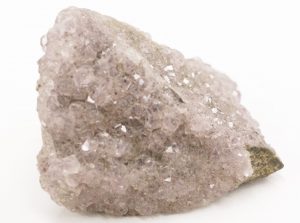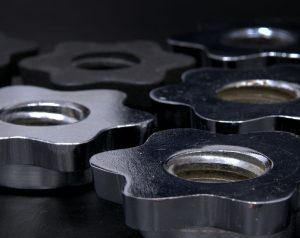D5.3 Ionic Compounds
Applying Core Ideas: Two Substances, Some Similarities, Some Big Differences


Compare iron, which melts at 1811 K (1538 °C), and calcium fluoride, which melts at 1691 K (1418 °C). Are the forces between atomic-level particles similar in iron and calcium fluoride? Write in your notebook an explanation of your answer to this question.
Write in your notebook, then left-click here for an explanation.
Consider some other properties of iron and calcium fluoride.
- Iron has typical metallic properties: pure solid iron has metallic luster, is malleable, and conducts electricity.
- Calcium fluoride has significantly different properties: as a solid it is brittle, does not look metallic, and does not conduct electricity; when molten, calcium fluoride does conduct electricity though.
It appears that these two substances have similar attractions between atomic-level particles, but quite different properties. We need a better atomic-scale model to make sense of these differences.
In metals, which have low effective nuclear charges (and low ionization energies), it is relatively easy to form positive ions within a sea of electrons so that attractions among the ions and the electrons hold the atoms together. What happens when an atom with a low ionization energy interacts with an atom with a large negative electron affinity? In such a case, transfer of one or more electrons from the atom with the low ionization energy to the one with the high electron affinity can be energetically favorable. For example, consider transfer of an electron from a Li atom to a F atom to form a cation and anion close together: an ion pair, Li+F–.
Consider these three steps that result in formation of a LiF ion pair from a Li atom and a F atom:
- Remove the electron from the 2s orbital in a Li atom to form a Li+ cation.
- Add that same electron to the 2p orbital in a F atom to form a F− anion.
- Bring the Li+ ion close to the F− ion to form an ion pair.
Based on what you have learned so far, describe how you can obtain the energy change for each for these three processes.
Explain how you could do a calculation to verify this statement: The energy of a LiF ion pair is lower than the energy of a Li atom and a F atom. (Don’t actually do the calculation. Just explain how it could be done.)
Write in your notebook, then left-click here for an explanation.
Step 1: The Li ⟶ Li+ + e– process corresponds to the first ionization of Li. The energy change for this step is the first ionization energy of Li, which is +520.1 kJ/mol, according to the ionization energy table in the appendix.
Step 2. The F + e– ⟶ F– process corresponds to the electron affinity of F. The energy change for this step is given in the electron affinity table in the appendix as –327.95 kJ/mol.
Step 3. Approximating the ions as point charges, we can use Coulomb’s law to estimate the electrostatic potential energy. The distance is the sum of the ionic radius of Li+ and the ionic radius of F–. From the ionic radius table in the appendix, the ionic radii are 90 pm for Li+ and 119 pm for F–, so the distance between the ions is 209 pm.
Because Coulomb’s law applies to point charges (electric charges concentrated at a single point) and the ions have electron density spread over a significant volume, this calculation can only be an approximation. A more accurate and complex calculation takes into account repulsions among electrons and gives a potential energy of approximately –600 kJ/mol. This is the ion-pairing energy.
Calculation. The calculation of the overall energy change is
ΔE = IE1(Li) + EA1(F) + ion-pairing energy = 520.1 kJ/mol – 327.95 kJ/mol – 600 kJ/mol= –408 kJ/mol
Notice that without the ion-pairing energy, the energy change would be positive: the two ions are not more stable unless they are close together.
From the activity above, you’ve worked out that the formation of the ion pair is associated with a negative ΔE: the joined ion pair is lower in total energy (more stable) than the two atoms from which it formed.
The gain and loss of electron(s) in forming an ion-pair typically results in a full octet for the cation and anion. For example:
When a large number of ions form, anions and cations form a structure, called an ionic crystal lattice, where the total number of anions and cations together result in zero total electric charge. In this lattice, each anion has several cations as its nearest neighbors, and each cation has several anions as its nearest neighbors (see example in Figure below). This arrangement maximizes anion-cation attractions (smaller r results in lower Coulomb’s law energy) and minimizes anion-anion and cation-cation repulsions (greater r between anions and between cations). A compound made up of anions and cations is called an ionic compound and the overall attraction making an ionic crystal lattice stable is called ionic bonding.
For example, when sodium cations (Na+) and bromide anions (Br−) come together, the crystal lattice of the compound sodium bromide (shown in the figure above) contains one Na+ (green) for each Br− (violet). The chemical formula representing the part of the lattice shown in the figure is Na75Br75 because there are 75 Na+ and 75 Br− ions. The actual crystal is much larger, so the subscripts in the formula of a real crystal would be huge. A formula unit is a group of chemical symbols that indicates the smallest whole number ratio of ions of each kind that make up the substance, and is typically used as the formula for ionic compounds. Thus, the formula unit (and the formula) for sodium bromide is NaBr.
All chemical substances are overall electrically neutral. Thus, in an ionic compound, the positive charge from all the cations must equal to the negative charge from all the anions. In other words, the subscripts in a formula unit of an ionic compound must result in equal quantities of positive and negative charges. If we know the charges of the ions, then we can write the formula.
An oxygen atom can accept two electrons and achieve a full octet while a sodium atom can donate one electron and achieve a full octet. So the ionic compound sodium oxide has the formula Na2O.
Predict formulas for the oxides of Li and Cs and write the formulas in your course notebook.
Use the idea of periodic repetition to predict formulas for oxides of Mg and Ga and write a formula for each compound in your notebook. Then use the explanation link below to view formulas and explanation.
Write in your notebook, then left-click here for an explanation.
Because the formulas of chemical compounds are similar in columns in the periodic table (periodic groups) and Li and Cs are in the same group as Na, the formulas should be Li2O and Cs2O.
Based on the ideas about formation of ions, atoms of group 2 elements should easily lose two electrons and form 2+ ions. Because oxygen can accept two electrons, it should take one oxygen atom to bond with one atom of a group 2 element. Thus, the formulas for the oxide of Mg should be MgO.
Ga is in group IIIA and has three valence electrons. This implies it can donate three electrons. We need to look for a way to combine an electron donation of three with an electron acceptance of two (for oxygen). The simplest way is to combine three O atoms (total of 6 electrons accepted) with two Ga atoms (total of 6 electrons donated). Thus, the formula is Ga2O3.
Some ions consist of a group of atoms with an overall charge. Examples include sulfate dianion, SO42−, dihydrogen phosphate anion, H2PO4−, and ammonium cation, NH4+. It is quite useful to be able to recognize such polyatomic ions and their charges. If you need to refresh your knowledge of polyatomic ions, use the reference table as you do the next two exercises.
Exercise: Ionic Compounds with Polyatomic Ions
Exercise: Formulas for Ionic Compounds
Please use this form to report any inconsistencies, errors, or other things you would like to change about this page. We appreciate your comments. 🙂 (Note that we cannot answer questions via the google form. If you have a question, please post it on Piazza.)

